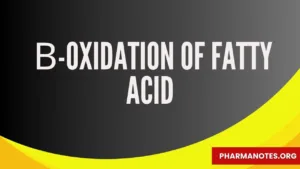β-Oxidation of Fatty Acid

β-Oxidation of fatty acid:
β- Oxidation may be defined as the oxidation of fatty acids on the β -carbon atom, this results in the removal of two carbon fragments of acetyl Co-A and acyl Co-A.

1. Activation of fatty acid:
Long-chain fatty acids are activated to fatty acyl Co-a by the enzyme thiokinase where ATP splits to AMP and PP (Pyrophosphate) in the prescience of enzyme A and Mg +2
2. Transport of acyl-Co-A into mitochondria (Carnitine transport system):
The inner mitochondria membrane is impermeable to fatty acids. A specialized carrier system operates to transport activated fatty acid from the cytosol to the mitochondria. This occurs in four steps:

3. β- Oxidation:
Energetics of β- Oxidation (Palmitic acid):
Mechanism:
1. β- Oxidation (7 cycles)
2 FAH2 [oxidized by ETC, each FAH2 H gives 2ATP]: 14
7 NADH [oxidized by ETC, each NAH gives 3ATP] : 21
2. Form 8 Acetyl-CoA
Oxidized by citric acid cycle, each 8 x12 = 96
Total energy from one male of palmityl-CoA = 131
Energy utilized for formation of palmityl-CoA = 02
The net yield of oxidation of one male of Palmitate = 129

The biosynthesis of fatty acid takes place in two phases.
1. Malonyl CoA formation.
Acetyl-CoA reacts with CO2 in the presence of ATP to form malonyl- CoA with the help of an enzyme acetyl- CoA carboxylase.
2. Fatty acid synthetase complex reactions.
The multi-enzyme complex known as fatty acid synthetase (FAS) take place in the fatty acid synthesis FAS complex consists of two similar subunits (Dimer). Each monomer subunit consists an acyl carrier protein (ACP) attached with its 4-phasphontheine group.
The following set of reactions each step in the formation of 16 carbon palmityl-CoA in cytostal.
1. An enzyme acetyl-CoA ACP transcyclase catalyses transfer of two carbon containing acetyl-CoA to ACP of fatty acid synthatase
complex. The acetyl moiety is further transferred from ACP to the cysteine residue of the enzyme. This makes the ACP site of the
enzyme vacant.
2. The molecule of malonate from malonyl-CoA is transformed to ACP of FAS complex catalyzed by the enzyme malonyl CoA ACP
transcyclase.
3. The enzyme β-keto acyl ACP synthatase catalyzes their reaction in which acetyl group attached to cysteine of FAS complex is
transferred to the malonyl unit already attached to ACP of the FAS complex with removal of CO2 to form β-keto acyl ACP.
4. The β-keto acyl ACP reductase reduces β-keto acyl ACP in to β-hydroxy acyl ACP with the help of reducing equalant supplied by
NADPH.
5. The β-hydroxy keto acyl ACP dehydrogenase. Brings the dehydration of β-hydroxy keto acyl ACP with the elimination of H2 into
molecule to form trans 2 Enoyl ACP.
6. An enzyme Enoyl ACP reacts brings about the NADPH dependent reduction. This produces acyl ACP (Butaryl group). The carbon
chain so formed is now transferred to cysteine residue of FAS complex.
The 6 more cycles of reaction from 2-6 take place respectively. Each cycle (2-6) increases the chain length of the growing fatty acid
by 2 carbon atoms.
For detailed PDF Notes Click on the Download Button
